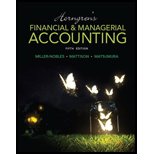
Horngren's Financial & Managerial Accounting (5th Edition)
5th Edition
ISBN: 9780133866292
Author: Tracie L. Miller-Nobles, Brenda L. Mattison, Ella Mae Matsumura
Publisher: PEARSON
expand_more
expand_more
format_list_bulleted
Concept explainers
Question
Chapter 13, Problem 4QC
To determine
Valuation principle: As per the principle, the stock issued in exchange of assets other than cash, the company is required to record the transaction at the market value of the stock issued, or at the market value of the asset received whichever is clearly determinable. Thus, the particular asset acquired is debited, and the common stock and the paid in capital-common stock, if any are credited.
To find: at which value the building should recorded.
Expert Solution & Answer
Want to see the full answer?
Check out a sample textbook solution
Students have asked these similar questions
I am searching for a clear explanation of this financial accounting problem with valid methods.
Hii, Tutor Give answer
Please provide the answer to this general accounting question using the right approach.
Chapter 13 Solutions
Horngren's Financial & Managerial Accounting (5th Edition)
Ch. 13 - Prob. 1QCCh. 13 - Prob. 2QCCh. 13 - Suppose Value Home and Garden Imports issued...Ch. 13 - Prob. 4QCCh. 13 - Prob. 5QCCh. 13 - Assume that a company paid 6 per share to purchase...Ch. 13 - Prob. 7QCCh. 13 - A small stock dividend a. decreases common stock....Ch. 13 - Jackson Health Foods has 8,000 shares of 2 par...Ch. 13 - Prob. 10QC
Ch. 13 - Prob. 1RQCh. 13 - Prob. 2RQCh. 13 - How does authorized stock differ from outstanding...Ch. 13 - What are the four basic rights of stockholders?Ch. 13 - How does preferred stock differ from common stock?Ch. 13 - Prob. 6RQCh. 13 - What are the two basic sources of stockholders'...Ch. 13 - Prob. 8RQCh. 13 - If stock is issued for assets other than cash,...Ch. 13 - Prob. 10RQCh. 13 - Where and how is treasury stock reported on the...Ch. 13 - What is the effect on the accounting equation when...Ch. 13 - What are the three relevant dates involving cash...Ch. 13 - How does cumulative preferred stock differ from...Ch. 13 - What is a stock dividend?Ch. 13 - Prob. 16RQCh. 13 - What are some reasons corporations issue stock...Ch. 13 - Prob. 18RQCh. 13 - What does the statement of retained earnings...Ch. 13 - What is a prior-period adjustment?Ch. 13 - Prob. 21RQCh. 13 - What does earnings per share report, and how is it...Ch. 13 - What is the price/earnings ratio, and how is it...Ch. 13 - What does the rate of return on common stock show,...Ch. 13 - Prob. 13.1SECh. 13 - Journalizing issuance of stock- at par and at a...Ch. 13 - Journalizing issuance of stock-no-par Ashford...Ch. 13 - Journalizing issuance of stock- stated value...Ch. 13 - Journalizing issuance o f stock for assets other...Ch. 13 - Prob. 13.6SECh. 13 - Accounting for cash dividends Frenchroast Company...Ch. 13 - Dividing cash dividends between preferred and...Ch. 13 - Prob. 13.9SECh. 13 - Prob. 13.10SECh. 13 - Prob. 13.11SECh. 13 - Preparing a statement of retained earnings Tinder,...Ch. 13 - Analyzing the effect of prior-period adjustments...Ch. 13 - Prob. 13.14SECh. 13 - Prob. 13.15SECh. 13 - Prob. 13.16SECh. 13 - Prob. 13.17ECh. 13 - Prob. 13.18ECh. 13 - Journaling issuance of stock Skylar Systems...Ch. 13 - Prob. 13.20ECh. 13 - Prob. 13.21ECh. 13 - Prob. 13.22ECh. 13 - Journalizing treasury stock transactions and...Ch. 13 - Journalizing issuance of s tock and treasury stock...Ch. 13 - Computing dividends on preferred and common stock...Ch. 13 - Computing dividends on preferred and common stock...Ch. 13 - Journalizing a stock dividend and reporting...Ch. 13 - Prob. 13.28ECh. 13 - Reporting stockholders' equity after a stock split...Ch. 13 - Determining the effects of cash dividends, stock...Ch. 13 - Prob. 13.31ECh. 13 - Prob. 13.32ECh. 13 - Computing earnings per share and price/earnings...Ch. 13 - Computing rate of return on common stockholders'...Ch. 13 - Organizing a corporation and issuing stock John...Ch. 13 - Identifying sources of equity, stock issuance, and...Ch. 13 - Prob. 13.37APCh. 13 - Journalizing dividends and treasury stock...Ch. 13 - Journalizing dividend and treasury stock...Ch. 13 - Prob. 13.40APCh. 13 - Prob. 13.41BPCh. 13 - Prob. 13.42BPCh. 13 - Prob. 13.43BPCh. 13 - Journalizing dividends and treasury stock...Ch. 13 - Journalizing dividend and treasury stock...Ch. 13 - Prob. 13.46BPCh. 13 - Sources of equity and journalizing stock issuance...Ch. 13 - Prob. 13.1CTFSCCh. 13 - Prob. 13.1CTCA
Knowledge Booster
Learn more about
Need a deep-dive on the concept behind this application? Look no further. Learn more about this topic, accounting and related others by exploring similar questions and additional content below.Similar questions
- I am looking for the correct answer to this financial accounting question with appropriate explanations.arrow_forwardPlease help me solve this financial accounting question using the right financial principles.arrow_forwardWhat is the budgeted total product cost of it operaes at 75% capacity ?arrow_forward
- Can you solve this financial accounting problem using accurate calculation methods?arrow_forwardCould you explain the steps for solving this financial accounting question accurately?arrow_forwardI am trying to find the accurate solution to this financial accounting problem with the correct explanation.arrow_forward
arrow_back_ios
SEE MORE QUESTIONS
arrow_forward_ios
Recommended textbooks for you
- Principles of Accounting Volume 1AccountingISBN:9781947172685Author:OpenStaxPublisher:OpenStax College
 Financial And Managerial AccountingAccountingISBN:9781337902663Author:WARREN, Carl S.Publisher:Cengage Learning,
Financial And Managerial AccountingAccountingISBN:9781337902663Author:WARREN, Carl S.Publisher:Cengage Learning, Cornerstones of Financial AccountingAccountingISBN:9781337690881Author:Jay Rich, Jeff JonesPublisher:Cengage Learning
Cornerstones of Financial AccountingAccountingISBN:9781337690881Author:Jay Rich, Jeff JonesPublisher:Cengage Learning

Principles of Accounting Volume 1
Accounting
ISBN:9781947172685
Author:OpenStax
Publisher:OpenStax College

Financial And Managerial Accounting
Accounting
ISBN:9781337902663
Author:WARREN, Carl S.
Publisher:Cengage Learning,

Cornerstones of Financial Accounting
Accounting
ISBN:9781337690881
Author:Jay Rich, Jeff Jones
Publisher:Cengage Learning